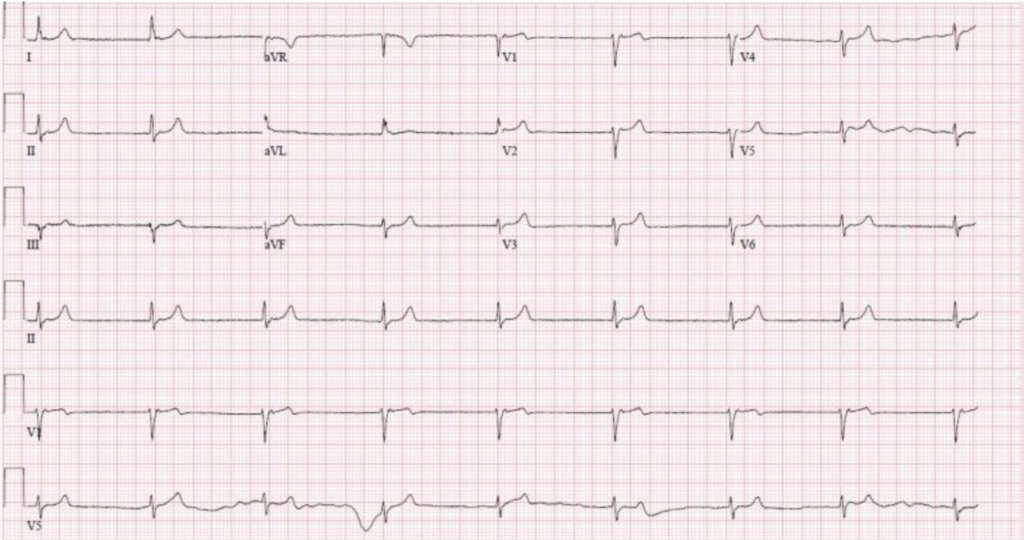Case Presentation
History
A 55-year-old male presented with progressive weakness and numbness in his legs, difficulty walking, and occasional episodes of confusion over the past six months. He reported a strict vegan diet for the past ten years and denied any gastrointestinal symptoms or significant medical history.
Examination
Upon examination, the patient exhibited:
- General Appearance: The patient appeared pale and mildly disoriented but cooperative.

- Vital Signs: Blood pressure, heart rate, and temperature were within normal limits.
- Neurological Examination:
- Cranial Nerves: Intact. No abnormalities in vision, hearing, or facial movements.
- Motor System:
- Power or Strength: 4/5 in the lower extremities, slightly reduced compared to the upper extremities.
- Tone: Normal in both upper and lower extremities.
- Reflexes: Hyperreflexia noted in the lower extremities with brisk knee and ankle reflexes. Positive Babinski sign (upgoing plantar reflex).
- Sensory System:
- Proprioception and Vibration: Markedly reduced in the lower limbs, particularly below the knees.
- Light Touch and Pain Sensation: Mildly reduced in the lower extremities.
- Romberg’s Test: Positive. The patient swayed significantly with eyes closed.
- Coordination: Difficulty with heel-to-shin test, more pronounced on the right side.
- Gait: Ataxic and unsteady, with a broad-based stance and difficulty performing tandem walking.
- Mental Status: Mild cognitive impairment noted, with difficulty recalling recent events and slight disorientation to time.
Labs
Laboratory investigations revealed:
- Complete Blood Count (CBC): Low Hb (Anemia), Elevated mean corpuscular volume (MCV = 108fL), indicating macrocytic anemia.
- Serum Vitamin B12: Significantly low.
- Methylmalonic Acid (MMA) and Homocysteine Levels: Elevated, confirming functional B12 deficiency.
- Intrinsic Factor Antibodies: Positive, suggesting pernicious anemia.
Diagnosis
Based on the history, clinical examination, and laboratory findings, a diagnosis of Subacute combined degeneration (SCD) of the spinal cord secondary to vitamin B12 deficiency was made.
Overview
Subacute combined degeneration (SCD) of the spinal cord is a severe neurological disorder resulting from a deficiency in vitamin B12. It primarily affects the spinal cord, leading to progressive deterioration if left untreated.
What is Subacute combined degeneration (SCD) of the spinal cord?
Subacute combined degeneration (SCD) of the spinal cord is a condition characterized by the degeneration of the spinal cord due to inadequate vitamin B12. This deficiency leads to demyelination, primarily affecting the dorsal and lateral columns of the spinal cord. Consequently, patients experience significant neurological impairments.
Causes
The primary cause of SACD is vitamin B12 deficiency, which can stem from several factors:
- Dietary insufficiency: Common in vegetarians and vegans who do not supplement their diet with B12.
- Malabsorption syndromes: Conditions like pernicious anemia, Crohn’s disease, or celiac disease impair the absorption of B12.
- Gastrointestinal surgeries: Procedures such as gastric bypass can hinder B12 absorption.
- Medications: Certain drugs, including metformin and proton pump inhibitors, can interfere with B12 absorption.
Signs and Symptoms
SACD presents with a range of neurological symptoms, often developing insidiously. Key symptoms include:
- Sensory disturbances: Tingling, numbness, and a “pins and needles” sensation, especially in the hands and feet.
- Motor dysfunction: Weakness, difficulty walking, and a feeling of unsteadiness.
- Cognitive changes: Memory loss, confusion, and mood disturbances.
- Other symptoms: Fatigue, glossitis (inflamed tongue), and pallor.
Diagnosis
Diagnosing SACD involves a combination of clinical evaluation, laboratory tests, and imaging studies:
- Clinical evaluation: Detailed neurological examination to assess sensory and motor deficits.
- Laboratory tests: Measurement of serum vitamin B12 levels, complete blood count (CBC), and metabolic panel. Elevated methylmalonic acid (MMA) and homocysteine levels support the diagnosis.
- Imaging: MRI of the spinal cord may show characteristic changes such as hyperintensity in the dorsal and lateral columns.
Treatment
Early intervention is crucial in managing SACD. Treatment focuses on replenishing vitamin B12 levels and addressing the underlying cause:
- Vitamin B12 supplementation: Intramuscular injections of B12 are often administered initially, followed by oral supplements once levels are stabilized.
- Dietary modifications: Patients are advised to incorporate B12-rich foods or supplements into their diet.
- Treat underlying conditions: Managing conditions like pernicious anemia or gastrointestinal disorders that contribute to B12 deficiency.
Complications
Without timely treatment, SACD can lead to severe and irreversible complications:
- Permanent neurological deficits: Continued progression of sensory and motor dysfunction.
- Cognitive decline: Persistent memory loss and cognitive impairment.
- Increased fall risk: Due to gait abnormalities and balance issues.
Conclusion
Subacute Combined Degeneration of spinal cord is a serious condition that necessitates prompt diagnosis and treatment. Awareness of its causes, symptoms, and treatment options can significantly improve patient outcomes. In cases of vitamin B12 deficiency, early intervention and appropriate management can prevent the progression of neurological damage and ensure a better quality of life for affected individuals.

